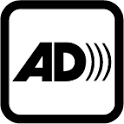Audio Description (or AD) is essentially a kind of descriptive narration that conveys visual information in the form of words to people who are blind or have low vision, or who for whatever reason can’t fully appreciate visual content. In the USA, it’s often called Descriptive Video (or DV) but this is only in its function as a descriptive track for film and television. I’ve included here the internationally recognised symbol for AD which is used to identify programs or events that have Audio Description provided. Many DVDs, for example, include AD as a menu option, although not all DVDs have their menus described, thereby limiting access to their own accessibility features!
Audio Description ideally fits in between dialogue and/or sound effects in visual media – be that a theatre performance, an art installation, or a film or TV program. AD can describe such things as environment, time of day, body language, facial expressions and meaningful actions of characters, or such things as text, colours and shapes that form part of the work being described. Good Audio Description will prioritise describing the most salient points of the visual content in a clear and concise way, within the time available.
The primary purpose of AD is to convey information about visual content to an audience with blindness or low vision, but it does have other applications. For example, people learning English or children with cognitive differences have found descriptive narration to be useful in identifying and naming visual information and cues. If you’re sighted, you may unwittingly already be an audio describer when you’re experiencing some kind of visual stimulus that you want to convey to somebody you know who, for whatever reason, can’t see what you’re seeing.
In the realm of film and TV, the scope for AD really depends on the genre of the material and the kind of program it is, as some programs leave almost no gaps between dialogue in which the visuals can be sufficiently described, while others contain large tracts of silence or background music which can be voiced over with the AD narrative track. But AD can extend to any kind of visual content, because, really, anything that can be seen can be audio described.


Recent Comments